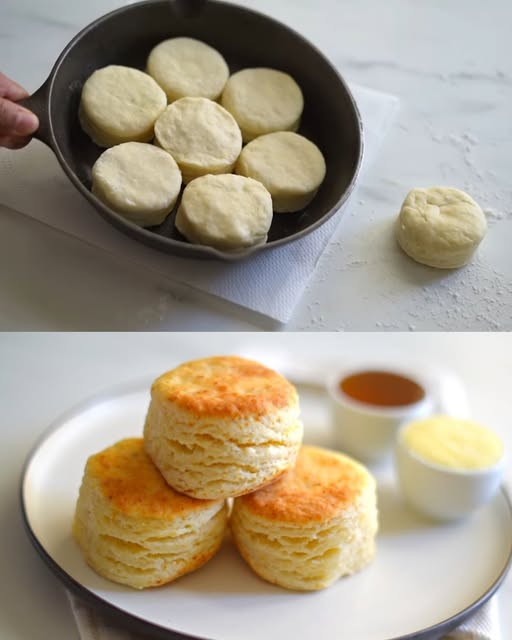Warm, golden, buttery biscuits are the kind of comfort food that never goes out of style. Whether served with a pat of butter and a drizzle of honey, smothered in sausage gravy, or accompanying a hearty dinner, biscuits are beloved across many cuisines, particularly in the American South. This recipe yields beautifully fluffy, flaky, and tender biscuits using simple pantry ingredients. With no yeast and minimal kneading, these biscuits come together quickly and bake up like a dream.
The secret to a perfect biscuit lies in cold butter, proper folding, and a hot oven. Once you’ve tried these homemade buttermilk-style biscuits, you may never reach for the store-bought kind again.
Cooking Time
-
Preparation Time: 15 minutes
-
Cooking Time: 12–15 minutes
-
Total Time: 30 minutes
-
Yield: 10–12 medium-sized biscuits
Ingredients
-
2 cups all-purpose flour
-
2 teaspoons baking powder
-
½ teaspoon salt
-
1 tablespoon granulated sugar
-
½ cup (1 stick) cold unsalted butter, cut into cubes
-
¾ cup cold milk (preferably whole milk or buttermilk)
Step-by-Step Cooking Directions
-
Preheat the oven: Set your oven to 425°F (220°C). Line a baking sheet with parchment paper.
-
Combine the dry ingredients: In a large mixing bowl, whisk together the flour, baking powder, salt, and sugar.
-
Cut in the butter: Add the cold, cubed butter to the flour mixture. Use a pastry cutter or your fingertips to rub the butter into the flour until the mixture resembles coarse crumbs. You should still see small pea-sized pieces of butter—this is key for flakiness.
-
Add the milk: Pour the cold milk into the bowl. Stir gently with a fork or spatula just until the dough starts to come together. Do not overmix.
-
Shape the dough: Turn the dough out onto a floured surface. Gently pat it into a rectangle about 1-inch thick. Fold it in half, turn it, and pat it out again. Repeat this folding process 2–3 times to create flaky layers.
-
Cut the biscuits: Pat the dough out to about ¾ inch thick. Use a round biscuit cutter (or a drinking glass) to cut out biscuits. Press straight down without twisting to ensure even rise. Gather scraps and re-roll gently as needed.
-
Bake the biscuits: Place the biscuits onto the prepared baking sheet, close together for softer sides or spaced apart for crispier edges. Bake for 12–15 minutes, or until golden brown on top.
-
Optional—brush with butter: For extra flavor and shine, brush the tops of the hot biscuits with melted butter as soon as they come out of the oven.
Nutritional Information
(Per biscuit, based on 12 biscuits)
-
Calories: 170
-
Fat: 9g
-
Saturated Fat: 5g
-
Carbohydrates: 19g
-
Sugar: 2g
-
Protein: 3g
-
Fiber: 1g
-
Sodium: 220mg
The Origins and Popularity of the Recipe
Biscuits are a staple of Southern American cuisine, with origins tracing back to early colonial times. Originally known as “beaten biscuits” in the 1800s, they evolved into the fluffy, leavened versions we know today with the invention of chemical leaveners like baking powder. Over time, biscuits became a symbol of Southern hospitality and comfort, often found alongside dishes like fried chicken, BBQ, and sausage gravy. Today, they are enjoyed throughout the U.S. and around the world.
Reasons Why You’ll Love the Recipe
-
Simple Ingredients: No exotic items—just flour, butter, milk, and basic pantry staples.
-
Quick and Easy: From start to finish in under 30 minutes.
-
Versatile: Serve with sweet toppings, savory meals, or enjoy plain.
-
Customizable: Add herbs, cheese, or spices to tailor them to your taste.
-
Beginner Friendly: No yeast or advanced techniques required.
Health Benefits
While biscuits are often considered indulgent, homemade versions offer some nutritional benefits over store-bought:
-
No preservatives or additives
-
Control over ingredients and portion size
-
Option to substitute with whole wheat flour or plant-based milk
-
Natural fats from butter vs. hydrogenated oils in processed brands
Of course, moderation is key. Pairing these biscuits with nutrient-dense foods like eggs, lean protein, or fresh fruits can create a balanced meal.
Serving Suggestions
-
Breakfast: With scrambled eggs and bacon or alongside jam and fruit.
-
Brunch: Smothered in creamy sausage or mushroom gravy.
-
Dinner: As a side for chili, fried chicken, or roast vegetables.
-
Sweet treat: Split and filled with whipped cream and berries for a quick strawberry shortcake.
Common Mistakes to Avoid
-
Overmixing the dough: This leads to tough, dense biscuits. Mix just until combined.
-
Using warm butter or milk: Cold ingredients are crucial for flakiness.
-
Twisting the biscuit cutter: This can seal the edges and prevent proper rising.
-
Skipping the fold technique: Folding creates those signature layers.
-
Crowding the baking tray (if you want crisp sides): Space biscuits apart for more browned edges.
Pairing Recommendations
-
Drinks: Try with black coffee, Southern sweet tea, or orange juice at breakfast.
-
Main Dishes: Serve with fried chicken, barbecue ribs, or creamy soups.
-
Condiments: Pair with honey butter, fruit preserves, or herbed cream cheese.
Cooking Tips
-
Use a grater to shred the butter if you don’t have a pastry cutter—it makes it easier to mix evenly.
-
Chill the dough for 10 minutes before cutting to keep butter cold.
-
Preheat your oven fully before baking to ensure maximum rise.
-
Use a sharp cutter for clean edges that help the biscuit rise straight and tall.
-
Brush tops with cream or milk before baking for a golden crust.
Similar Recipes to Try
-
Cheddar Chive Biscuits – Add shredded cheese and fresh herbs for a savory twist.
-
Drop Biscuits – No rolling or cutting, just scoop and bake.
-
Buttermilk Cornbread – Another Southern classic that pairs with many meals.
-
Savory Scones – Slightly firmer, with added cheese, ham, or veggies.
-
Garlic Herb Biscuits – Perfect with Italian meals or hearty stews.
Variations to Try
-
Sweet Biscuits: Add 2 tablespoons of sugar and a touch of cinnamon. Serve with fruit.
-
Cheese Biscuits: Mix in ¾ cup of grated cheddar or gouda.
-
Herbed Biscuits: Add 1 tablespoon of finely chopped rosemary, thyme, or parsley.
-
Spicy Biscuits: Add a pinch of cayenne or finely chopped jalapeños.
-
Whole Wheat Biscuits: Replace half the flour with whole wheat flour for extra fiber.
Ingredient Spotlight: Butter
Butter is the heart of any good biscuit. It provides richness, flavor, and most importantly, structure. When cold butter hits the hot oven, it steams, creating pockets of air that give biscuits their flakiness. For best results, use unsalted butter so you can control the salt level in your recipe. European-style butter with higher fat content will yield extra rich results.
Conclusion
Homemade flaky buttermilk biscuits are one of those foundational recipes that reward you with far more flavor and comfort than the effort it takes to make them. With only a few ingredients and some simple techniques, you can have a basket of warm, tender biscuits ready to share with friends and family. Once you master the basics, the options for customization and pairing are nearly endless. Whether you’re making breakfast, lunch, or dinner, a good biscuit never fails to impress.
10 Frequently Asked Questions
1. Can I use buttermilk instead of milk?
Yes! Buttermilk is traditional and adds a tangy flavor and extra tenderness. Use an equal amount.
2. Can I make the dough ahead of time?
Yes, shape the biscuits and refrigerate them for up to 24 hours before baking. You can also freeze them.
3. What’s the best flour to use for biscuits?
All-purpose flour works well, but for even fluffier biscuits, use a low-protein flour like White Lily.
4. How do I get my biscuits to rise high?
Use cold ingredients, don’t overwork the dough, and place biscuits close together if you want taller ones.
5. Can I freeze baked biscuits?
Absolutely. Let them cool, then freeze in an airtight container for up to 3 months. Reheat in the oven.
6. Why are my biscuits dry or crumbly?
You may have added too much flour or overmixed the dough. Be gentle and accurate when measuring.
7. How do I make vegan biscuits?
Use a plant-based butter and non-dairy milk like almond or soy. Make sure baking powder is vegan-friendly.
Advertisement
8. What can I add for more flavor?
Try garlic powder, onion powder, herbs, cheese, or even diced cooked bacon.
9. Can I make these gluten-free?
Yes, use a 1:1 gluten-free baking flour blend. The texture may differ slightly but will still be delicious.
10. Should I use a food processor to mix the dough?
It’s an option, but manual mixing gives more control and prevents overmixing. If using a processor, pulse briefly.

